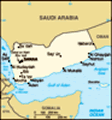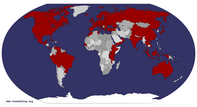Advertisement
Published: January 10th 2007

 Khat vendor
Khat vendor
Man selling Khat at the local market in Sana'aYemen part IV - The south and the west
First I'd like to write a little about the habit of chewing
khat. Khat is in most countries in the World considered a drug and consequently illegal. In countries where it is legal however, for instance in Yemen but also in Ethiopia for instance, it is used by a very high percentage of the population. The male population I should add. I'm not sure but I don't think women ary very big khat chewers. I'll get back to what I know about the women in Yemen later on.
In the afternoon in Yemen most men carry around small plastic bags with fresh green leaves in it. It is the daily stash of khat. They chew the leaves one by one or a few at the time. When the leaves have been ground into a green soup they put the leaves in their cheeks and go on chewing new leaves. After an hour or so the men have a big bulge in their cheek making them look like a mouse on a feeding frenzy or like Dizzie Gillespie. They keep the Khat in the cheek probably for hours while enjoying the

 Khat vendor
Khat vendor
Man selling Khat at the local market in Sana'aeffects of the drug.
I haven't tried Khat. It is supposed to be a mild drug. If you ask locals who chew Khat regularly they say that it has all kinds of positive effects. Some say it is calming others say it gives them energy. Some say it makes them sleepy others say it makes them alert and so on. Most westerners who try Khat say they don't notice any effects at all from it.
I have seen Yemeni men chewing Khat while working or while relaxing in front of the TV and even while driving a car. It doesn't matter what the men are doing they always chew Khat in the afternoon.
To me the use of Khat sounds surprisingly much like the use of coffee. Mild drug that has different effect on different people and that is widely used. I guess the biggest difference is that I will never get a prison sentence from drinking a cup of coffee but I might get one from chewing Khat.
I have twice been asked to try to find out how women are treated in Yemen. This turned out to be more or less impossible for me

 Khat vendor
Khat vendor
Man selling Khat at the local market in Sana'ato do. Almost all women in Yemen are when they are in public dressed in a black veil covering the entire body except for the eyes and the hands. Several times I asked women wearing the veil for permission to take photos of them but nobody agreed. The few photos I have I have either taken without permission or I have taken a photo of something else and the women walked into the picture by mistake.
Being a western man trying to take any contact with women in Yemen is totally futile. If I would try I would most likely only get a hostile or frightened look as a response. So therefore I couldn't really find out much about women's situation in Yemen. But I'll try to write down the few things I do know or think I know and I'll leave it to you to draw your own conclusions.
From what I understand men and women don't really interact at all unless they are either married or are closely related. Some women did actually approach me when begging for money. But they didn't say very much. They more or less just stood there with a hand out

 Two young men chewing Khat
Two young men chewing Khat
These two men are chewing Khat. Look at the bulge in their cheeks.probably saying "Please" in Arabic. I have heard women say one or two words when they have asked me to step aside in a crowded street or something similar. But I was never able to have any conversation or anything like that with any local women during my two weeks in Yemen.
Marriages are very often arranged so wife and husband have often never met before the wedding. Wedding ceremonies are interesting by the way. Ivan and I witnessed one in central Sana'a one evening. This was not the actual ceremony though, rather a wedding related party. In this party only the groom and his relatives and friends were present. No women at all! The women had their party elsewhere.
Women can have a job but never in any position where they must have contact with people. In the hotels we lived all the employees were male. The salesmen in the markets and in the shops were all men. However, Harvey had to talk to not less than two bank managers when he tried to cash his traveller's cheques, both of them women.
As I have mentioned before most women wear black clothes covering the entire body

 DUI
DUI
Our driver was happily chewing Khat while driving. In Sweden that would be known as driving under influence and would probably render a rather big fine.except eyes and hands as soon as they were in public. There seem to be very few exceptions from that code of dress. During my two weeks in Yemen I don't think I saw one single women older than 15 showing her hair. In some stores we saw other, more western style, clothes such as jeans and blouses. But those clothes seem to be only for the family to see.
I have received one more question that I'd like to answer before I get on with telling you about our adventures the last days I was in Yemen. It is about food. The typical food we had while we were in Yemen was stir fried vegetables, stir fried beans or some kind of stir fried meat. Stir frying seems to be the standard way to prepare food in Yemen. I some restaurants we also had fried or grilled fish and sometimes we could order chicken curry or a meat stew. But, as I said, when we asked for some kind of food they usually stir fried it.
I would also before I go on like to mention the dirt in the streets. In every town there was a

 Khat plantation
Khat plantation
Here is a photo of a field were they grow Khat. layer of rubbish on the streets. Everybody threw empty cans, plastic bags and other kind of garbage right on the street. Sometimes I was forced to do the same thing simply because in many towns there are no rubbish bins.
The worst thing in Yemen was not the dirt in the streets or the poverty or the threat that we might get abducted in the tribal areas. It was the lack of decent coffee. In Yemen they grow coffee but none of it seems to be consumed within the country. In some places it was possible to get instant coffee, which is a poor substitute for the real thing but at least it takes the edge off the worst withdrawal symptoms. But for me, a genuine coffee addict, the lack of coffee was a nightmare and I have to admit that it sure is good to be back home where I at any time of the day can brew a cup and make it just as strong as I want.
Now, after this much too long introduction, I'd like to get to the travel tales.
After a brief visit back in Sana'a we took a tour to

 Wedding party
Wedding party
This is a picture from a wedding party that took place in central Sana'a one evening. The groom is towards the right end of the picture holding a sword. Note that there are only men who attend the party. The women have their own party elsewhere (and certainly not in public).the south and over to the west i Yemen. The first interesting visit there we made in a town called Ibb. The old town in Ibb I found very interesting because many houses there reminded me of medieval cities in Europe. I have a soft spot for medieval cities so was enjoying that the visit there a lot.
An hour or so south of Ibb is a small town just off the highway that has nothing of interest to it other than its name - Al Qaidah. For all I know the name has nothing at all to do with the terror organization. We felt that we just had to make a stop there and have a photo of the town's name on a street sign. The only one we found was in Arabic though.
Later on this trip we came to two costal towns - Al-Khawkhah and Al-Hudaydah. These towns are both rather important ports in the Red Sea. For thousands of years traditional boats, so called Dhows, have been used for shipping cargo between the countries around the Red Sea. These boats are made from wood and often painted in bright nice colours. In Al-Hudaydah we

 Dirty street
Dirty street
This is a photo of a typical back street in a typical Yemeni town. The street is littered with old bottles, plastic bags and other rubbish.got more than our share of Dhow boats. It was the day off for the fishermen in town so all the boats in town were moored in the harbour. It was an amazing sight to see hundreds of these wonderfully painted boats lying there side by side.
In the west of Yemen we one day visited the market in Beyt Al-Fakih. This market is supposed to be one of the liveliest in entire Yemen, but at least it proved to be one of the muddiest. The streets were covered with mud that sometimes was ankle deep or more. I wonder if the market in Beyt Al-Fakih could be muddiest market in the World?
After we left the Red Sea coast we headed up the Haraz mountains towards Sana'a. Haraz Mountains holds some of the highest peaks in the entire Arabic Peninsula. Thanks to the altitude the mountains get more rain than any other region in Yemen thus making it the most fertile part of Yemen. On the mountainsides they grow coffee, fruit, corn and of course khat. The scenery in mountains is truly amazing. The mountainsides with their terraces with fertile plantations, the green trees and the tiny

 Old town in Ibb
Old town in Ibb
Houses in the old town in Ibb reminded me of medieval cities in Europevillages covering every other mountain top like a little cap. It was a nice contrast to the rest of the country, where the land was mostly barren and dead.
The last day I was in Yemen we visited a town called Al-Hajjarah. It is an ancient village built on top of an isolated mountain top. I don't have reliable information on how old the village is but it might be as old as 1000 years. But the reason to visit the village is not the old age but the dramatic scenery and the amazing views. It was absolutely breathtaking to see the houses clinging to this tiny rock.
This is the last blog entry for this trip. I hope you all enjoyed reading it. Next time I get around to make a new entry is hopefully going to be in the end of February.
Take care,
Ake
Advertisement
Tot: 0.165s; Tpl: 0.036s; cc: 12; qc: 33; dbt: 0.0562s; 1; m:domysql w:travelblog (10.17.0.13); sld: 1;
; mem: 1.1mb





















alice
non-member comment
wonderful!
The blogs get better and better. I will miss reading them. thank you for all the vibrant details. Enjoy your coffee, and keep us posted on your next wanderings. Alice